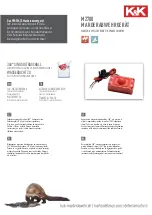
Chapter 5 - Maintenance
The following checkout procedure checks the simple trouble possibilities
before proceeding with extensive troubleshooting. The first steps assure
proper connection, operation, and calibration. If these checks do not locate
the trouble, the remaining steps help to locate any defective circuits or
components. When a faulty component is located, it should be replaced.
a) Check all control settings. Incorrect control settings may falsely
indicate trouble. Refer to Chapter 3 for the correct function or
operation of any control.
b) Visually check the unit. Indications such as broken wires, damaged
circuit boards, damaged components, etc can quickly identify many
problems.
c) Check associated equipment before proceeding with troubleshooting.
Verify that associated equipment is operating correctly, signals are
properly routed, and interconnecting cables are not defective.
Always remove power before opening the unit or replacing the
fuse. Failure to observe this warning may result in serious
injury or death.
d) Check ac power source. If fuse must be replaced, remove power cord,
slide open fuse cap, and replace fuse with the same type. After replacing
fuse cap, replace power cord. Turn power ON.
e) When isolating a fault, remember the following troubleshooting tips:
1) When the operator remote interface (ORI) PWB is running properly,
the row of LEDs (D10 - D12) will flash at about 2 Hertz. If the unit is
powered on and the LEDs are not flashing, the ORI board is in need
of replacement.
2) Eight LEDs (CR5 - CR12) on the servo board indicate various internal
functions:
(a) CR10 and CR12 indicate proper operation of the servo firmware
by running as a 2-bit counter.
(b) CR5 and CR7 indicate serial interface activity with the ORI PWB.
CR5 is toggled on every received command from the ORI. CR7 is
toggled after the reply to the ORI is sent.
3862 Autotrack Controller
5-3
Artisan Technology Group - Quality Instrumentation ... Guaranteed | (888) 88-SOURCE | www.artisantg.com
















































